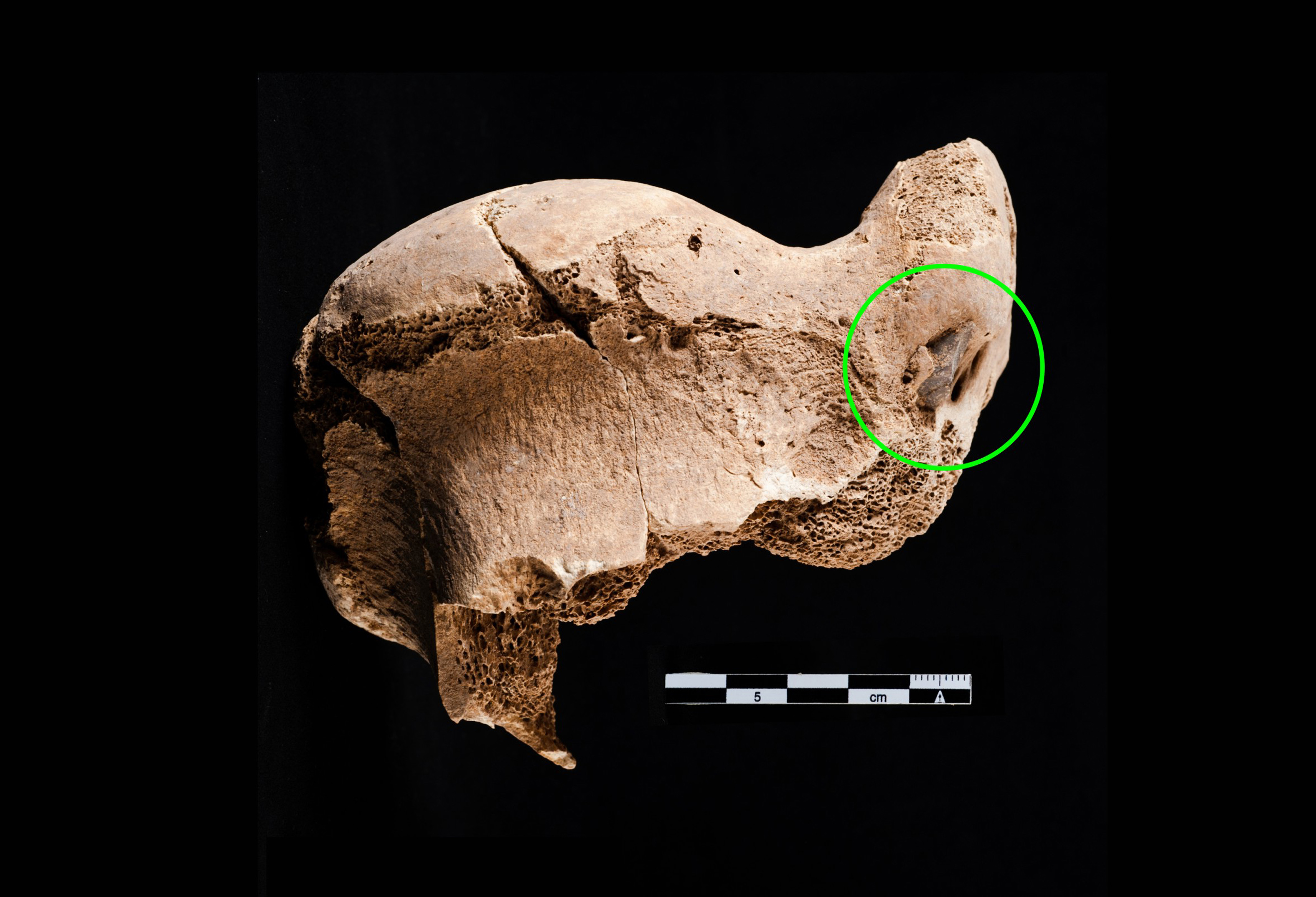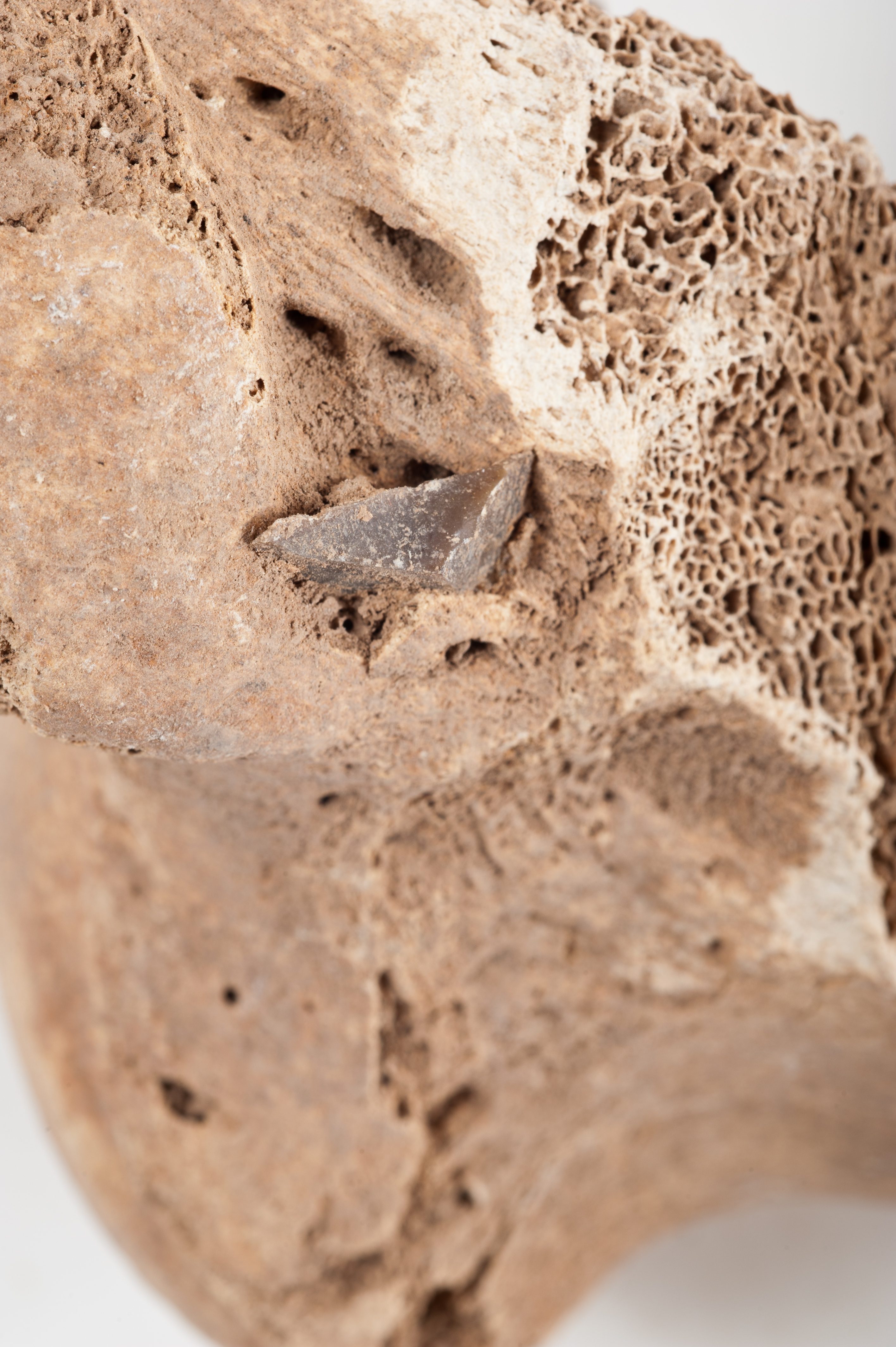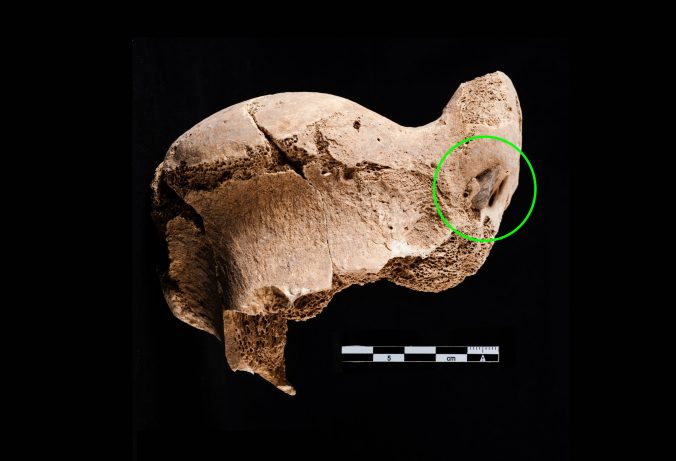All archaeological finds of a site add to its history, but some can capture us with the underlying story. This is the case for an aurochs bone with an embedded flint projectile point fragment discovered during excavations at Göbekli Tepe some years ago.
That the aurochs was an important animal to these early Neolithic hunters becomes evident not only through the impressive number of its bones present in the enclosures’ filling (remains hinting at the consumption of enormous amounts of meat, most likely during feasts in the course of large-scale meetings and communal activities), but also due to its prominent role in Göbekli Tepe’s iconography (where recently the impressing depiction of what seems to be a dying or dead aurochs was reported).
In 2009, a humerus of an aurochs was found in the southwestern part of Enclosure D, more precisely in the last 10 cm of sediment covering the bedrock floor directly in front of the segment of the perimeter bench that connects Pillars 32, 33, and 38. Bones are frequent finds at Göbekli Tepe, and many of them can tell stories if ‘interrogated’ by archaeozoologists and archaeologists. But under closer examination, it became clear that this bone was special. It had the tip of the hunter’s arrowhead still embedded in it.

Aurochs humerus with embedded flint projectile point from Göbekli Tepe’s Enclosure D. (Photo: N. Becker, DAI)
Hunting trauma in bones in general, and embedded projectile points in particular, are very rare finds. There are several reasons for this situation. The most important one probably is that hunters would aim for soft tissue to rapidly kill dangerous big game like cattle. The shot at the Göbekli Tepe aurochs thus has to be considered a miss from the Neolithic hunter’s point of view. But, as often, things that went wrong in prehistory hold the potential to be very informative for archaeologists (see Pompeii, for example). In this case, the bone offers the possibility to reconstruct a certain moment in time roughly 12,000 years ago.

Aurochs humerus with embedded flint projectile point from Göbekli Tepe´s Enclosure D. Detail of the projectile point fragment (copyright DAI, photo N. Becker).
To do so, we have to examine the bone a little closer. First, there is some information to be gained about the unfortunate animal. The fused proximal epiphysis indicates an adult aurochs older than four years, while bone measurements illustrate that we are dealing with a cow. Put scientifically, the position of the point suggests that the projectile penetrated the Musculus cleidobrachialis and the M. infraspinatus, and probably also the M. deltoideus and M. triceps brachii covering the lateral side of the proximal humerus, and became lodged in the cranial part of the proximal epiphysis at the base of the Trochanter major, at an angle of about 90°. As such, the position of the tip indicates that the hunter must have stood to the right side or the right front of the animal and broadly at the same height. As shown by experiments and proven by ethnographical records, the maximum distance between hunters and big game prey is usually between 10 and 40 meters irrespective of using spears or bow and arrow. From distances larger than that, hit rates are low and all game within the reach would be on the run, if the first shot was a miss.
Hunters therefore try to get as near to the animals as possible. That the Göbekli hunters did not stand too far from his prey is also suggested by the fact that the impact was powerful enough to cut through the muscles overlying the humerus at this position and to get stuck in the bone. This shot was certainly not fatal but it at least impeded the animal. Since no traces of healing are visible on the damaged bone, it was hunted down soon after this hit. As mentioned, the shot can be considered a miss and was most likely aimed at the rib cage in order to hit the lungs and/or the heart – the most effective method when hunting middle-sized to large animals.
It is such finds that offer the rare opportunity to switch from sketching out the big lines of history to individual stories. Even if we do not have much more information on what happened exactly that day some 12,000 years ago, one can imagine how a group of hunters stalked the animal in the gallery woods surrounding smaller streams in the valleys around the Germus mountains. How they came face to face with the beast, maybe at a distance of no more than 10 m. How one of them aimed for the first shot, hit the large and dangerous animal, but not fatally. How others sprang to his aid to bring the angry opponent down. And finally, how the story of this particular hunt was retold for years at campfires.
More Information on this discovery can be found in the following article, available here (external link, text behind paywall):
Nadja Pöllath, Oliver Dietrich, Jens Notroff, Lee Clare, Laura Dietrich, Çiğdem Köksal-Schmidt, Klaus Schmidt, Joris Peters, Almost a chest hit: An aurochs humerus with hunting lesion from Göbekli Tepe, south-eastern Tukey, and its implications. Quaternary International. DOI: 10.1016/j.quaint.2017.12.003

Thanks Oliver. Pls could you tell me the calibrated carbon date for the bone and what its position tells us about when it was (am guessing ritually?) placed with regard to the overall construction of Enclosure D. Presumably it was killed/sacrficed/used at least after the floor and benches were constructed?
Secondly, it seems such a shame that your longer paper on this is behind a paywall. I hope, you – as academics – fight to get your work in the public domain, where it should be.
Thirdly, even though interpretation of Gobekli Tepe may never be complete, are there plans to publicise all finds/ season reports/ photographs/drawings/ 3d models online – even if detailed explanations are not yet forthcoming? This would allow a wider community of scholars and the general public the chance to analyse the data. I know that your are producing a monograph and have been working on it for some time but i was told a couple of years ago it was coming out ‘soon’. Rather than working on a single publication, isn’t a version of TepeTelegrams – continually updated with raw data – a sensible approach?
best,
STEF
1. There is no calibrated radiocarbon date for the bone. There is a radiocarbon age obtained on animal tooth from a superimposing excavation unit (L9-67, Loc. 55.2) which would be indicative of a PPNA age for the underlying deposits (KIA-44701, 9800 ± 120 14CBP). The aurochs was shot with an arrow, not sacrificed, its position in the lowest layers above the enclosure´s floor may imply that it was part of the intentional backfill, but we are still discussing the exact formation processes of the backfill layers.
2. You can be sure that we do care about the dissemination of our research. This basically is the reason why the blog you are reading exists. Open Access in high-ranked journals depends on funding at the moment, which often is not available. This is not a good situation obviously, and we are trying to make information available nevertheless. There is also the option to drop us a message asking for a pdf copy of any published article.
3. The official excavation reports are online in fact: http://www.kulturvarliklari.gov.tr/TR,44760/kazi-sonuclari-toplantilari.html, as are the English versions published regularly in Neo-Lithics (http://www.exoriente.org/downloads/neolithics.php). We have also uploaded all other published materials as far as publishing agreements allow this.
We are not producing one monograph at the moment. There are several people working on different subjects, and things will get, and really constantly are, published .
Thank you Oliver. I was not able to find the 2016 excavation report in the link. Does the above mean I can get a pdf copy of your longer version of this paper? I think the work you are doing is great but was making a more general point about data – e.g. all photos / location of objects – being available (even if definitive interpretation is some ways off)
best,
STEF
Send me a mail and I‘ll send you the paper next week.
you report the animal tooth as 9800 calBP here and in the longer paper (tks for emailing) and then assign it to PPNA? But isn’t PPNA 11600-10700 calBP?
No. Let me repeat. There is a radiocarbon age obtained on animal tooth from a *superimposing* excavation unit (L9-67, Loc. 55.2) which would be indicative of a PPNA age for the *underlying* deposits (KIA-44701, 9800 ± 120 14CBP). The excavation unit *above* the bone was dated. The material *below * it could be older or as old as the tooth. But doesn‘t have to, because there are still uncertainties about the refilling process.
And 14C BP doesn’t even mean a calibrated date. This is a raw date, uncalibrated. The calibrated age is 9746-8818 calBC at the 95.4% confidence level.
ok sorry, tks. I thought it was a calibrated date. (that was my original question)
“the impressive number of its bones present in the enclosures’ filling”
Can you provide numbers? What qualifies as “impressive”? If the aurochs bone fragment was part of the filling, might it not be from a different culture, or tribe, than the one(s) that built the structures?
This preliminary report gives some numbers: http://sciencepress.mnhn.fr/sites/default/files/articles/pdf/az2004n1a13.pdf
All material found at Göbekli Tepe is PPNA-middle PPNB. The only question is the exact date of the refilling event(s) within this period. See also the discussion on radiocarbon data in this thread.
I wonder if the builders of Gobekli Tepe ate less meat than we do, and if the focus on feasting says more about researchers than the data. Hunters in Oregon kill some 50,000 deer and elk a year; how many bone fragments does one year’s worth of hunting leave? More than found for thousands of years at the ancient site?
Göbekli Tepe does not seem to have been a permanent settlement with people staying and living there all year round. We thus need to keep in mind that the animal bones present in these enclosures’ filling do not at all represent the complete alimentation of the hunter groups building and using them – but rather a rather small part of this only. Namely that time tthese groups met on the site (for these feasts probably). Also, the bone material unearthed shows a clear selection (i.e. of aurochs for example only the body parts particularly rich in meat are represented) – hunted game thus seems to have been dissessambled and prepared elsewhere.
Agreeing to Oliver’s comment above, adding that the filling material does not only consist of animal bones, but is also mixed with other remains of material culture like stone tools, stone vessels, plaquettes, shaft straighteners etc. pp. representing characteristic PPN types and bearing the same iconogrpahy as can be seen on this and other sites of the region.
Pls could you be more specific about the (presumably ritual?) placement of the bone. I think you mean in front of the bench connecting pillar 32,33 pillar 38 (not 28) which (even coloured in the longer article) is quite a wide area for a bone that size. Also, in the longer article you go back to mid-summer – autumn rather than late autumn for seasonal use. Does that mean you have found potential water sources? Pistachio still ripens in Urfa late august i think..
1. Thanks for pointing out the typo.
2. There is no indication of a ritual placement of the bone. It is hard to say whether a bone with an embedded (rather small) flint fragment would have been regarded as something special (I am not aware of such cases), or if the fragment even was noticed. The part of the aurochs most often taken as a “trophy” during the PPN (but absent from GT) is the skull, or a part of it, with the horns.
3. There are no new water sources, “The end of the summer and in autumn” (p. 15) is the general timespan the archaeozoologists involved in our project assume for the presence of gazelle herds in the vicinity of GT. We have not discussed the exact moment of construction activities at the site in the article.
Tks. Its not just the presence of Gazelle herds is it but rather the presence of gazelle bones of a particular age that were eaten? I was not referring to construction but rather ‘use’.. i thought you had moved to later autumn (if these enclosures were used seasonally) for water reasons..
It seems that the paper by Lang et al. is available to read online on Researchgate. This should be consulted for details of their argumentation.
i read the paper. It’s one of your papers (on this blog) which moved the seasonal occupation to late autumn for water reasons. Is that still your view?
You asked about the ages of gazelle hunted. Yes, I still think that the need for provision with water could mean larger construction activities were restricted to times when rainwater and food were available. We have a team of geographers and geologists looking i. a. for water sources right now, so this may change.
tks.. i’m was asking more about when the feasts are (after construction)
..i mean isn’t seasonal feasting bound to mark particular events – e.g. after prime gazelle/auroch hunt times or pistachio harvest or einkorn collection etc?
Ethnographic analogies for work feasts indicate feasting after the activity in question. There is however a wide range of social causes for feasting that may have played a role at GT, e.g. initiation rites etc.
What is in the climactic record around GT between 12-11,500 yrs ago? Oak/Pistaschio forest returning, climate more similar to today?
I think the best overview can be found here: Rosen, AM; (1998) Early to Mid-Holocene environmental changes and their impact on human communities in Southeastern Anatolia. In: Issar, A and Brown, N and Shilony, Z, (eds.) Water, Environment and Society in Times of Climatic Change, pp. 215-240.
Also: R. Neef, Overlooking the Steppe-Forest: A Preliminary Report on the Botanical Remains from Early Neolithic Göbekli Tepe (Southeastern Turkey). Neo-Lithics 2/03: http://www.exoriente.org/docs/00046.pdf [external link]
tks.. the most up-to-date science on this is 15-20 yrs old?
That was what first came to my mind, not an exhaustive overview on palaeoenvironmental research in SE/Turkey.
Pustovoytov, K., Schmidt, K., & Taubald, H. (2007). Evidence for Holocene environmental changes in the northern Fertile Crescent provided by pedogenic carbonate coatings. Quaternary Research, 67(3), 315-327. doi:10.1016/j.yqres.2007.01.002
You may also have a look at Roberts, The Climate of Neolithic Anatolia, in the last volume of Neolithic in Turkey (2015).
cheers..
Beautiful posts!! Looks like it’s gonna be my new favorite blog. Thank you guys for sharing all these so beautifully!!!
It’s interesting that the weapon was mentioned as an arrow while it’s obviously a pike.
What makes you think so? The measurements of the preserved fragments fit with an arrowhead
It was broken during the “bullfight”. A flint headed arrow (or spear) simply cannot be shot with enough velocity to embed into a bone after penetrating through oxhide and the.soft tissue.
Ist actually can. There are lots of ethnographic examples and experimental archaeological studies on that (some cited in the paper published on this find in Quaternary International). The best known example for cattle hunt with bow and arrow surely is the bison hunt of northamerican indigenous peoples.
Just to give you an example of an aurochs brought down by arrows: The Aurochs from Vig in Denmark – https://en.natmus.dk/historical-knowledge/denmark/prehistoric-period-until-1050-ad/the-mesolithic-period/the-aurochs-from-vig/the-hunters-arrowheads/
Well, there are contemporary hunters in US calling themselves “traditional” or “primitive” archers. They even have a magazine. They can kill deer and elk with a single shot of obsidian or flint headed arrows.
Ox and bison is different. Their hide is so thick, even modern bow hunters rely on death through bleeding after several shots.
As your article states, the danish aurochs was killed the same way, with at least tree shots. If its hunter(s) could launch arrows with enough velocity, one shot could cause a deep wound and kill by internal demage. A stone arrow just doesn’t have that kinetic energy.
Forget embedding into an aurochs bone after penetrating the hide and the muscle. Or consult Ryan Gill. He has a website about stonehead arrow archery.
The aurochs from Vig actually has bone damage from the arrows: https://en.natmus.dk/historical-knowledge/denmark/prehistoric-period-until-1050-ad/the-mesolithic-period/the-aurochs-from-vig/the-aurochs-deasly-struggle/
Does it have any embedded arrowhead in the bones?
Bones have holes the size of the arrowheads, which thus clearly pierced hide and muscles.